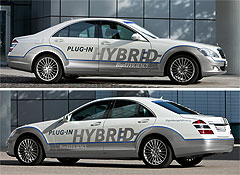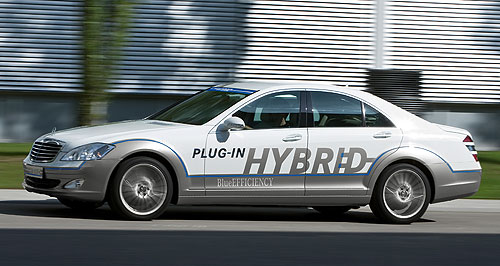Future models - Mercedes-Benz - S-Class - Vision S500 Plug-in HybridFirst look: Mercedes plugs in its S-class limoLuxo hybrid: The Vision S500 Plug-in Hybrid can run for 30km on electric propulsion. Mercedes-Benz unveils S500 plug-in hybrid as part of Frankfurt showcase14 Sep 2009 By TERRY MARTIN MERCEDES-BENZ has made another move to take the high ground on hybrids and electric vehicles at this week’s Frankfurt motor show, unveiling another near-production eco car – this time, a plug-in hybrid version of the S-class luxury sedan. Joining a trio of small B-class-based electric cars and a diesel-electric E-class dubbed the Vision E300 Bluetec hybrid in Frankfurt, the Vision S500 Plug-in Hybrid features an all-new drivetrain that combines a “new-generation” 3.5-litre direct-injection V6 petrol engine with a 44kW/250Nm electric motor and 10kWh lithium-ion battery pack to achieve some incredibly impressive performance figures. According to Mercedes, the green limousine can accelerate from 0-100km/h in 5.5 seconds on its way to a top speed of 250km/h, yet return combined-cycle NEDC fuel consumption of 3.2L/100km. Its claimed CO2 emissions are no less impressive – just 74g/km.  Although preliminary at this stage, the mileage and emissions figures benefit from the plug-in hybrid’s ability to drive for up to 30km in full-electric zero-emissions mode. Although preliminary at this stage, the mileage and emissions figures benefit from the plug-in hybrid’s ability to drive for up to 30km in full-electric zero-emissions mode.Recharging a fully discharged battery using a conventional household socket takes about 4.5 hours, while a rapid charge cycle takes less than an hour. The vehicle is also equipped with an onboard charger, which is located in the side lining of the boot and is protected against short circuits, voltage reversal and voltage surges. It is also designed to protect the battery by monitoring voltage, the charging level and charging time. Mercedes describes the plug-in S500 as an “experimental vehicle” that demonstrates “the long-term viability of future S-class generations”. It is the second hybrid S-class the German manufacturer has rolled out this year, following the S400 Hybrid’s debut at the New York auto show in April. “The Vision 500 Plug-in Hybrid is a new milestone on our path toward zero-emission mobility,” said Daimler chairman and Mercedes-Benz Cars chief Dieter Zetsche. “It is a luxurious and safe S class that offers superior driving performance while at the same time consuming less fuel than current compacts. “All of this shows that our top models will also be able to combine automotive fascination with responsibility for the environment.” Mercedes head of R&D Thomas Weber said that it would take “some time” before the model went into series-production but said engineers were working “full steam” to do the necessary integration measures and ensure it met the demands required of a luxury long-distance sedan. “We’ve already got all the key technology we need for such a dream car, which is why I see it being included in the next generation of the S class,” he said. “The important thing now is that our development work be accompanied by the establishment of a full-coverage infrastructure that will allow the potential of this innovative drive system to be fully exploited.” Mercedes has used the same basic drive components as the S400 Hybrid for the plug-in S500, although the electric motor in this latest version is three times more powerful. As with the S400H, the plug-in S500 system includes a unique version of the brand’s 7G-Tronic seven-speed automatic transmission and offers braking energy recuperation and idle-stop functions. While lithium-ion batteries offer packaging advantages through their compact size, the higher-performing unit in the eco S500 has required more installation space than in the S400H, forcing Mercedes engineers to relocate the 130kg pack from the engine bay to behind the rear seats in the boot. In turn, Mercedes claims that this new position over the rear axle creates its own benefits, such as more balanced weight distribution. Another unique element of the plug-in S500 is an additional clutch integrated between the combustion engine and the electric motor, which decouples the two components in the full-electric drive mode to maximise efficiency in the latter. As well as serving as an energy storage device for the electric motor, the lithium-ion battery pack is also linked – via a DC-DC converter – to the 12-volt onboard network, which provides power to devices such as the headlights. To ensure a consistently high level of electrical efficiency, the voltage transformers are water-cooled via an additional low-temperature circuit. Meanwhile, the E300 diesel hybrid is described as a “near-series vehicle study” and is based on the same system, which in this application combines a 2.2-litre four-cylinder turbo-diesel engine with the 15kW electric motor used in the S400H – but goes a step further than the latter in also offering pure electric driving. Mercedes has not provided details on its EV range, but claims the vehicle – which has a combined output of 165kW and up to 600Nm – can achieve a combined fuel consumption figure of 4.5L/100km and emit just 119g/km of CO2.  Read more3rd of September 2009  First look: Benz reveals Volt-beating plug-in hybridMercedes expands future E-Cell electric car series with a plug-in hybridAll future models Alfa Romeo Alfa Romeo Abarth Abarth Audi Audi Aston Martin Aston Martin BMW BMW Bentley Bentley Chrysler Chrysler Chevrolet Chevrolet Dodge Dodge Citroen Citroen Ferrari Ferrari DS DS Ford Ford Fiat Fiat FPV FPV Foton Foton Haval Haval Great Wall Great Wall Honda Honda Holden Holden Hyundai Hyundai HSV HSV Isuzu Isuzu Infiniti Infiniti Jeep Jeep Jaguar Jaguar Lamborghini Lamborghini Kia Kia Lexus Lexus Land Rover Land Rover Mazda Mazda Maserati Maserati Mercedes-Benz Mercedes-Benz McLaren McLaren Mini Mini Nissan Nissan Mitsubishi Mitsubishi Peugeot Peugeot Opel Opel Proton Proton Porsche Porsche Renault Renault Ram Ram Saab Saab Rolls-Royce Rolls-Royce Smart Smart Skoda Skoda Subaru Subaru SsangYong SsangYong Tesla Tesla Suzuki Suzuki Toyota Toyota Volvo VolvoS-Class pricing
Motor industry news |
Click to shareMercedes-Benz modelsAll future models Alfa Romeo Alfa Romeo Abarth Abarth Audi Audi Aston Martin Aston Martin BMW BMW Bentley Bentley Chrysler Chrysler Chevrolet Chevrolet Dodge Dodge Citroen Citroen Ferrari Ferrari DS DS Ford Ford Fiat Fiat FPV FPV Foton Foton Haval Haval Great Wall Great Wall Honda Honda Holden Holden Hyundai Hyundai HSV HSV Isuzu Isuzu Infiniti Infiniti Jeep Jeep Jaguar Jaguar Lamborghini Lamborghini Kia Kia Lexus Lexus Land Rover Land Rover Mazda Mazda Maserati Maserati Mercedes-Benz Mercedes-Benz McLaren McLaren Mini Mini Nissan Nissan Mitsubishi Mitsubishi Peugeot Peugeot Opel Opel Proton Proton Porsche Porsche Renault Renault Ram Ram Saab Saab Rolls-Royce Rolls-Royce Smart Smart Skoda Skoda Subaru Subaru SsangYong SsangYong Tesla Tesla Suzuki Suzuki Toyota Toyota Volvo VolvoS-Class pricing
Motor industry news |
















Facebook Twitter Instagram